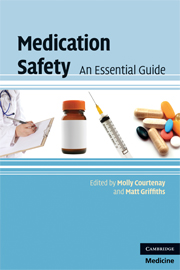Book contents
- Frontmatter
- Contents
- List of contributors
- Preface
- 1 Introduction to medication errors and medication safety
- 2 Safety in prescribing
- 3 Safety in dispensing
- 4 Safety in administering
- 5 Adverse drug reactions and drug interactions
- 6 Interface of care and communication
- 7 Parenteral drug administration
- 8 Calculations
- 9 Controlled drugs and patient safety
- 10 Reporting medication errors and near misses
- 11 Ensuring safety through evidence-based medicine
- Index
- References
6 - Interface of care and communication
Published online by Cambridge University Press: 22 January 2010
- Frontmatter
- Contents
- List of contributors
- Preface
- 1 Introduction to medication errors and medication safety
- 2 Safety in prescribing
- 3 Safety in dispensing
- 4 Safety in administering
- 5 Adverse drug reactions and drug interactions
- 6 Interface of care and communication
- 7 Parenteral drug administration
- 8 Calculations
- 9 Controlled drugs and patient safety
- 10 Reporting medication errors and near misses
- 11 Ensuring safety through evidence-based medicine
- Index
- References
Summary
Objectives
Identify the types of medication problems that arise at transition points in primary healthcare.
Explore the reasons why these problems occur.
Discuss possible methods of improving patient safety.
Summary
Interfaces and transitions relating to medicines use occur across healthcare settings and between healthcare professionals. This chapter focuses on primary care where the majority of medicines are prescribed and used. Medicines related problems (MRPs) have effects ranging from inconvenience, through impaired quality of life, to serious harm. There is increasing evidence that many MRPs are caused by communication failures and that future solutions need to include tackling the human causes of inadequate communication. Four medicines (anticoagulants, diuretics, non-steroidal anti-infl ammatories and antiplatelet medicines) are responsible for half of the medicines related hospital admissions and many of these episodes could be prevented with improved surveillance and interventions in primary care. Possible solutions are discussed including proactive monitoring in partnership with patients (including clinicians not making assumptions that someone else has ensured safety), the use of medicines review, and methods of strengthening patients' and carers' knowledge. All healthcare professionals should be vigilant and not assume that the correct prescription, supply, appropriateness and safety of medication has been checked already. Clinicians need to give adequate information to patients and check the patient' knowledge. All healthcare professionals should be vigilant and not assume that the correct prescription, supply, appropriateness and safety of medication has been checked already. Clinicians need to give adequate information to patients and check the patients or carer's knowledge at each stage. Patients should be regarded as experts in their own conditions and be encouraged to fl ag up any concerns.
- Type
- Chapter
- Information
- Medication SafetyAn Essential Guide, pp. 83 - 96Publisher: Cambridge University PressPrint publication year: 2009



